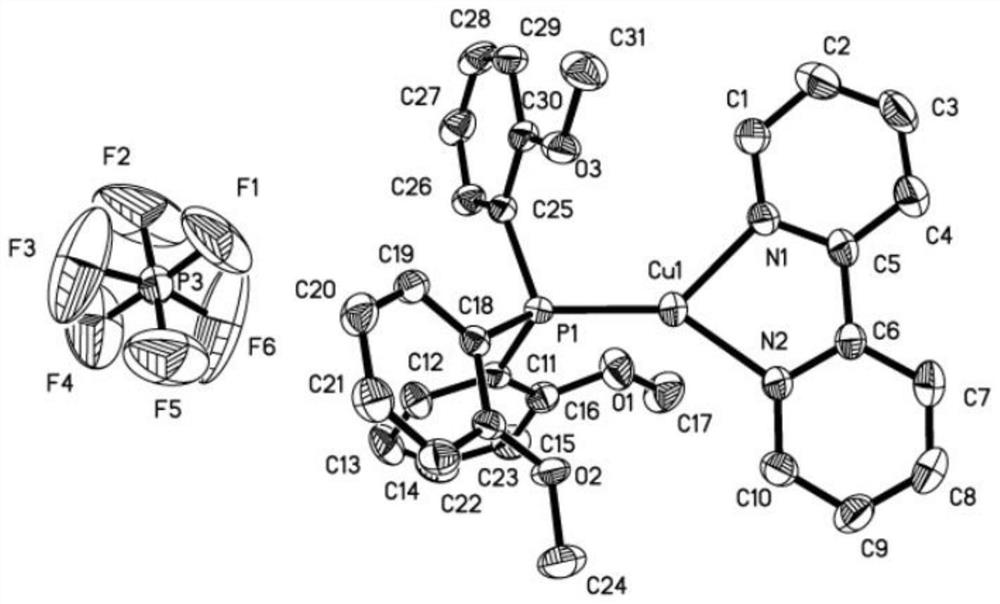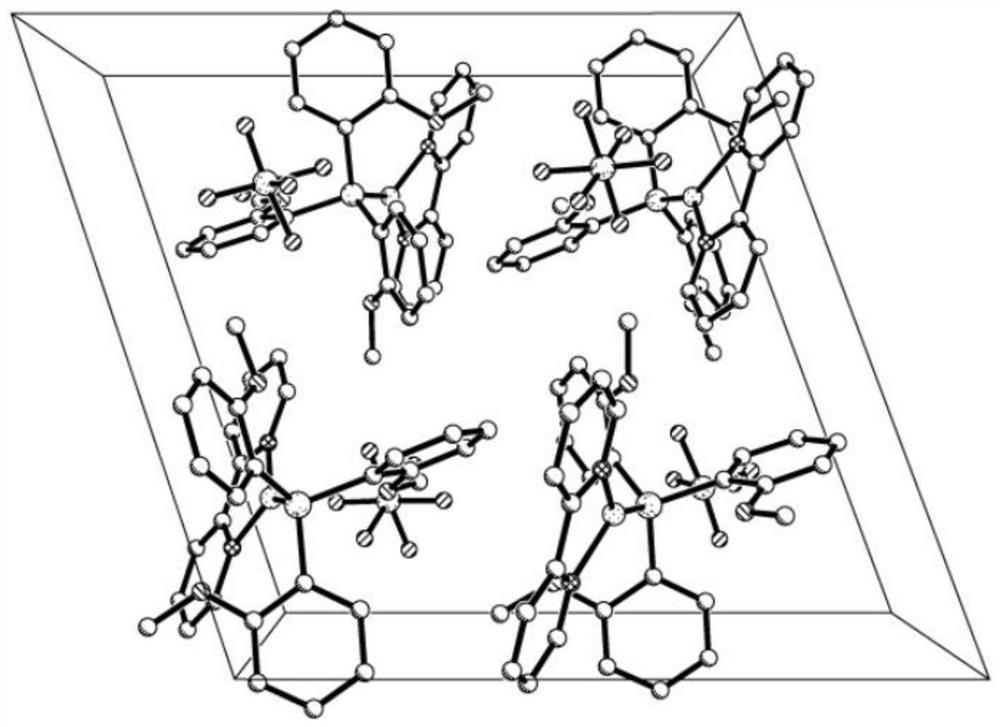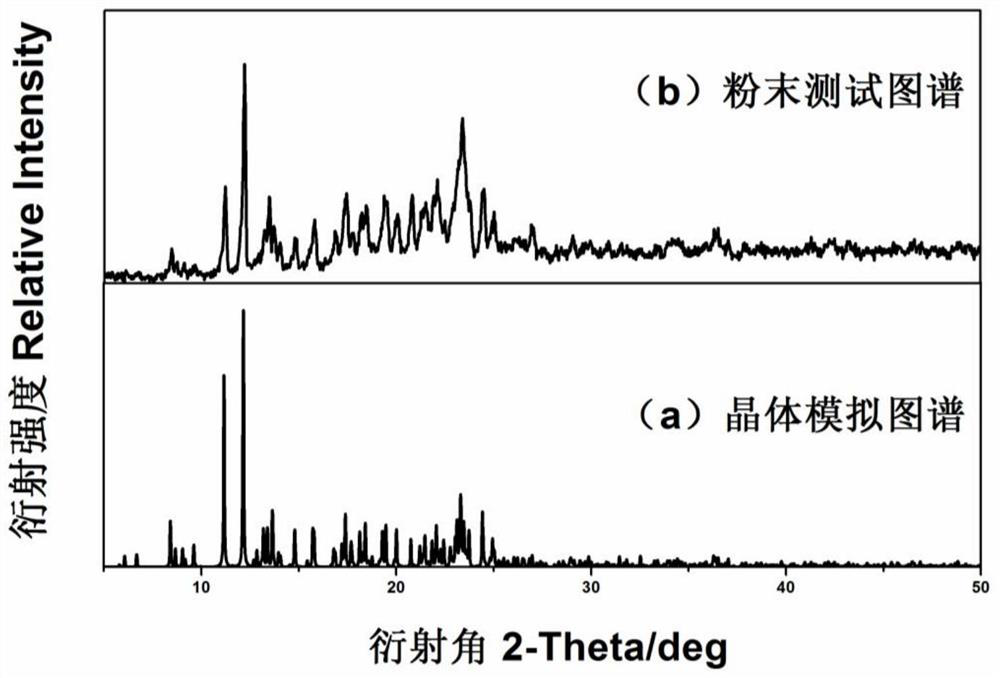A Cuprous Complex Fluorescent Sensing Material Selectively Responsive to 4-Pyridine Vapor
A technology for fluorescence sensing and complexes, applied in luminescent materials, compounds of Group 5/15 elements of the periodic table, fluorescence/phosphorescence, etc. The effect of good solubility and thermal stability, low production cost and simple equipment
- Summary
- Abstract
- Description
- Claims
- Application Information
AI Technical Summary
Problems solved by technology
Method used
Image
Examples
Embodiment 1
[0034] A large number of complex materials [Cu(O-Anisyl 3 P)(2,2'-bipy)](PF 6 ) Crystal sample preparation: Weigh 0.037g (0.1mmol) of Cu(CH 3 EN) 4 PF 6 , 0.035 g (0.1 mmol) of O-Anisyl 3 P, 0.016g (0.1mmol) of 2,2'-bipy; respectively dissolved in 5mL of dichloromethane and mixed sequentially, stirred well to make the coordination reaction fully occur, and obtained a reddish-brown clear solution; after filtration, the above solution was Rotary evaporation under reduced pressure at room temperature removed all solvents, and dried to obtain a light-colored crystalline powder product with a yield of 78% (calculated as Cu). After the complex was placed in the atmosphere of 4-picoline to respond, a very bright blue-green emission could be observed.
Embodiment 2
[0036] Synthetic complex materials [Cu(O-Anisyl 3 P)(2,2'-bipy)](PF 6 ) single crystal: Weigh 0.037g (0.1mmol) of Cu(CH 3 EN) 4 PF 6 , 0.035 g (0.1 mmol) of O-Anisyl 3 P, 0.016g (0.1mmol) of 2,2'-bipy; respectively dissolved in 5mL of dichloromethane and mixed successively, stirred well to make the coordination reaction fully occur, and obtained a reddish-brown clear solution; after filtration, the upper layer of the solution Covering with n-hexane promotes crystallization of the product, and after standing for a few days, a large number of green blocky crystals precipitate out. Select a near-colorless block crystal with a size of 0.40mm*0.38mm*0.32mm for X-ray single crystal structure test. The molecular structure of the compound is shown in the attached figure 1 , and its unit cell packing structure is shown in the attached figure 2 .
Embodiment 3
[0038] Preparation of fluorescent sensing film and its atmosphere response: Weigh 0.1 g of PMMA (polymethyl methacrylate, glass transition temperature: 105°C) to completely dissolve it in 2 mL of dichloromethane, and the solution is colorless, clear and transparent. Weigh 0.043g complex [Cu(O-Anisyl 3 P)(2,2'-bipy)]PF 6 , so that it was completely dissolved in 1 mL of dichloromethane, and the solution was reddish brown and clear. The complex solution was slowly introduced into the PMMA solution, and the solution was light orange-red and clear. Spin-coat (1200rad / min) on a cleaned quartz wafer, dry (60°C, 30min), and then put it into VOC to respond and test the fluorescence spectrum. It was found that a very bright blue-green emission (λem = 490 nm ) could be observed after responding in an atmosphere of 4-picoline. Besides, in other VOC atmospheres, it still does not emit light. The existence of various other VOC vapors has no obvious influence on the fluorescence sensing ...
PUM
| Property | Measurement | Unit |
|---|---|---|
| wavelength | aaaaa | aaaaa |
Abstract
Description
Claims
Application Information
 Login to View More
Login to View More - R&D Engineer
- R&D Manager
- IP Professional
- Industry Leading Data Capabilities
- Powerful AI technology
- Patent DNA Extraction
Browse by: Latest US Patents, China's latest patents, Technical Efficacy Thesaurus, Application Domain, Technology Topic, Popular Technical Reports.
© 2024 PatSnap. All rights reserved.Legal|Privacy policy|Modern Slavery Act Transparency Statement|Sitemap|About US| Contact US: help@patsnap.com










